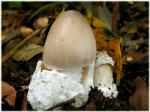Amanita imazekii ミヤマタマゴタケ
A new species, Amanita imazekii, from the central and eastern parts of the Japanese archipelago, is described. This fungus is a large mushroom with short striate and brown to grayish-brown pileus, saccate volva, annulus and non-amyloid globose to subglobose basidiospores. It is considered to be a new member of Amanita section Caesareae. The species may have an ectomycorrhizal relationship with trees of Pinaceae and/or Quercus.
Amanita imazekii: A New Species in Amanita Section Caesareae
Takashi Oda, Chihiro Tanaka and Mitsuya Tsuda
Mycologia Vol. 93, No. 6 (Nov. - Dec., 2001), pp. 1231-1234, Published by: Taylor & Francis, Ltd.
Topics: Amanita, Hyphae, Ellipsoids, New species, Basidiospores, Mixed forests, Mushrooms
Key Words: morphology, taxonomy
INTRODUCTION
During a phylogenetic study of the genus Amanita, we became aware that some Japanese Amanita species had been left unnamed. One of them was a large mushroom with a short striate and brown to grayish-brown pileus, saccate volva, annulus and non-amyloid globose to subglobose basidiospores. The late Dr. R. Imazeki had pointed out that this fungus might be a new species (lmazeki 1986), However, he did not formally publish a named species as new. The fungus had been collected repeatedly by members of local mycological clubs and given various Japanese names. Recently, we collected fresh specimens of the fungus. We checked the characteristics of the fungus based on newly collected materials. Here it is described as a new species.
MATERIALS AND METHODS Microscopic observation of tissues was made in 3%KOH. If necessary, the tissues were stained amoniac Congo red solutionm then rinced in 10% NHKOH and subsequently examined in 3% KOH. Basidiospores were measured at 1875x. Colors are according to Kornerup & Wanscher (1978).
------------------------------------------------------
Accepted for publication April 19. 2001.
TAXONOMY
Amanita imazekii Oda, Tanaka & Tsuda, sp. am: Pileus 6,14 cm lams, initio hemisphaericus, deinde con-VCXIIS vel planus, sae, infunctibuliformis. brunneus vel gr, seobrunneus, laevis, mottle breviter striatus. Lamellae lib. erae vel remotae, confertae. attenuatae, 6-10 nun lame, a, bac vel cremeae. Stipes 14-25.5 X 0.8-3.4 cm, sursum at-tenuatus. albus vel cremeus, pruinosus vel leviter floccosus, interduin !miter fibrillosus vel leviter squamulosus, fistula. sus vel solidus. Vain saccata, alba vel cremea. crassa, mem-branacea. semilibera. Annulus superior. interdum medi.
interdum 2- vel 3-sporigera. Sporae (8.0-) 8,10.8 (-12.0) 1.04 ± 0.04, globosae vel subgbbosae. inamyloideae.HOLO TYPUS: 12-1X-1996, T. Oda TNS—F-101510 (TM). Etymology. Named in honour of the late Dr. R. melt, Japanese pioneer in mycology. Pileus 6.5-14 cm in diam, at first hemispherical, then convex to plane, often uplifted, brown to gray-ish brown (5E3-7, 6E3-5, at center. often paler to-ward tnargin, smooth; margin short striate (0.09-0.22 R); trama, white. 0.6-1.2 cm thick at the center. La-mellae free to remote, attenuate, 6-10 mm broad, white to pale creamy, crowded, with edge pruinose to slighdy floccose; lamellulae one between ca 2-5 lamellae, truncate to subtruncate. Stipe 14-25.5 X 0.8-3A cm, attenuate upward. white to pale creamy. pruinose to slightly floccose, sotnetimes slightly fi-brillose to slightly scaly, hollow to stuffed. Volva saccate, white to pale creamy. lower one-third to two-thirds part attached to stipe, upper part thick, mem-branous, free, not spreading, with limb reaching one-third to half of stipe from stipe base; volval sac 2.5- 4.5 cm width. Annulus superior, sometimes to median, white, membranous. persistent. Smell unre-markable. Lamella vama bilateral. Lateral strata consisting of frequendy branching hyphae, 1-10 ixm wide, with many clamps, and inflated cells, elongate, cylinthi-cal, bacilliform, pyriform, clavate to fitsiform (16- X 7-25 pm); vascular hyphae few or absent. Mediostratum ca 30-60 p.m wide, consisting of frequently branching hyphae, 2, pin wide, with many clamps, and inflated cells. elongate, cylindrical, ba-cilliform, clavate to doliiform (20-80 X .20 pm); vascular hyphae a few or absent. Subhymenium ca







/http%3A%2F%2Fstorage.canalblog.com%2F09%2F49%2F1309869%2F102512115_o.jpg)
/http%3A%2F%2Fstorage.canalblog.com%2F31%2F84%2F1309869%2F102512113_o.jpg)
/http%3A%2F%2Fstorage.canalblog.com%2F04%2F07%2F1309869%2F99963695_o.jpg)
/http%3A%2F%2Fstorage.canalblog.com%2F68%2F50%2F1309869%2F122910444_o.jpg)